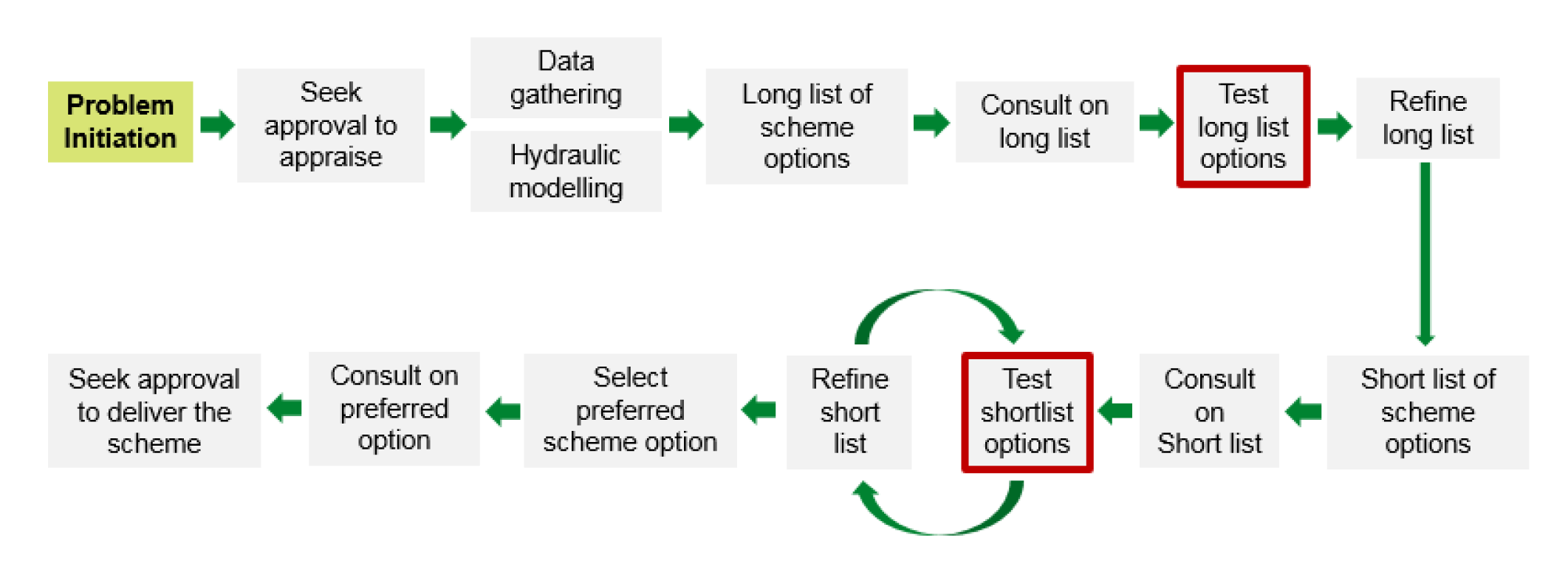
In summary the Environment Agency are spending Government’s money in providing flood risk management and they must follow their rules if they want to use their money. The first thing they are required to do in delivering a scheme is an appraisal.
According to the “Appraisal of flood and coastal erosion risk management, A Defra policy statement”:
All appraisals should:
| Define the issue | Define the issue and consider the case for Government intervention. Set Specific, Measurable, Achievable, Realistic and Time related objectives if there is a case |
| Develop, Describe and Value | Develop a full range of possible options, describe the options, and then value the positive and negative impacts of each of the options. |
| Compare and Select | Compare options in a systematic way and select the most effective and deliverable solution. |
For every possible Flood and Coastal Erosion Risk Management scheme around the country the Environment Agency (EA) must make the case to Government to provide the money to cover the scheme costs. Before giving them any money the Government require them to demonstrate that money spent on managing flood risk benefits the nation as a whole rather than just locally or specifically for a homeowner.
Government funds are limited and cannot fund all schemes or provide schemes that manage all flooding. There will always be schemes elsewhere in the country that are of more benefit to the nation than others. These schemes will be the first to attract funding from Government. There will always be some flood risk that the Government is prepared for the nation to live with, which means a scheme might not be funded. There comes a point when the costs of providing a scheme would be more than the costs of flooding.
Seeing as the EA are using Government’s money, Government set the rules and guidance for them to use to demonstrate the case to provide a scheme. Most importantly, because Government are considering spending money for the nation’s benefit, the EA must consider damage caused by flooding from a national perspective also.
This means a homeowner may incur costs of £70,000 to fix and replace damage caused by 30cm of floodwater in their property. When using the guidance for this same flooding the EA can only count the economic damage to the nation of this flood which might be as low as £20,000.
The EA also have to consider the probability of that flood happening to the house in the above example. If the 30cm of flooding was assessed to have a 1.3% (1 in 75) probability/chance of flooding per year, annually they can only claim 1.3% of £20,000 flood damage which is £260.
This makes the job of getting enough flood damages to outweigh scheme costs, as Government view flooding, a much harder task than it might appear at first.
The rules the Environment Agency follow to satisfy Government lead them through a process involving a number of stages, tests and approvals that must be undertaken before construction can begin.
The three key stages of a scheme are its appraisal, design and construction. From start to finish these stages combined can take anywhere between two to six years depending on their size and complexity. A simple small project might cost around £2-3 million. A large complex project £15 million or more.

The appraisal stage is about establishing a range of options to manage flood risk and comparing them to determine the best option overall. The Environment Agency (EA) are required to use the Flood and Coastal Erosion Risk Management Appraisal Guidance). The appraisal compares and “tests” the economic viability (costs and benefits), technical feasibility (engineering difficulty) and environmental impacts, including public acceptability. An overall summary of the stages they go through is shown in the flow chart below:

Detailed work that can take quite some time to complete within the flow chart include:
|
|
The flow chart shows that the EA start at a simple summary level (long list) and try to narrow options down to a short list that have the best chance of appealing to Government and attracting funding. As they move through the flow chart the level of detail they have increases. It doesn’t make much sense spending lots of time and money on options they know will struggle to make it through the process.
For example, at long list stage if the EA know one option costs twice as much as another option but provides the same level of protection (benefit) they would rule this option out and consider it no further. With the rules they must follow it is almost impossible to choose something costing twice as much for the same or similar outcome when considering that Government funds are limited and they must maximise value for money for the tax payer nationally.
Options the EA consider typically fall into one or a combination of the following themes:

At key stages the EA consult with partner organisations and the public to make sure they are taking on board the pro’s and cons of options from their perspective.
Selection of the final preferred option is typically the option that best balances economic, technical and environmental aspects. However, the economic case carries the most weight in decision making.
Within the guidance the Environment Agency (EA) must follow rules that determine how far they should go in terms of scheme costs and standards of flood protection.
| Increasing standard of flood protection → | ||||
| Option 1 5% (1 in 20) Scheme | Option 2 2% (1 in 50) Scheme | Option 3 1.3% (1 in 75) Scheme | Option 4 0.5% (1 in 200) Scheme | |
| Cost | £2M | £3M | £6M | £15M |
| Benefit | £20M | £40M | £50M | £60M |
| Benefit:Cost Ratio | 10:1 | 13:1 | 8:1 | 4:1 |
| STAGE 1 Lead Option | – | ♦ | – | – |
| Additional cost from previous option | – | – | £3M | £9M |
| Additional benefit from previous option | – | – | £10M | £10M |
| Incremental Benefit:Cost Ratio | – | – | 3.33:1 | 1.11:1 |
| STAGE 2 Preferred Option | – | – | ♦ | – |
The example above shows that the 1.3% standard scheme offers the best value to the Government and stands the best chance of being funded as it complies with their guidance and rules.
It also shows that flooding above a 1.3% chance will not be dealt with. A 0.5% flood could still happen and would overtop the 1.3% scheme the EA can justify. This means there is some flood risk that remains unmanaged, albeit with a low chance of happening.
Typically, the majority of flood damages avoided (benefits) come from frequent lower order flooding. Once the EA have dealt with this by offering the 1.3% (1 in 75) option, the flood risk from low probability high consequence flooding (0.5% / 1 in 200) is often small relative to additional scheme costs for dealing with it.
As scheme costs increase flood damages to offset the costs of providing a high standard tend to reduce. There are exceptions to this relationship linked to the geography of the site; flood mechanisms, type of property that floods and how costly / difficult it is to provide a scheme for a given standard of protection.
Before the scheme can progress to the design and construction stages the Environment Agency (EA) are required to submit a business case report to an independent assurance board for approval.
It is reviewed to make sure the work they have done and recommendations being made comply with the guidance and rules set by Government. The board also ensures the case is being made clearly and thoroughly enough to satisfy their own and Government’s quality standards. The review typically involves changes and updates to the business case requested by the assurance board, before they can recommend it for final approval.
Part of the business case includes the “Partnership Funding Calculator”. The EA must use this to calculate what percentage of total scheme costs the Government is prepared to pay for by using:
|
The Government is most interested in spending money to move homes out of high probability flood risk. In the Partnership Funding Calculator the EA must count homes moving from one band of flood risk to another using the following classifications:
|
Within the Partnership Funding Calculator, homes moving from very significant risk attract the most funding, then homes at significant and lastly moderate. A town made up of homes only at moderate flood risk would not stand a good chance of being funded.
The Partnership Funding Calculator prioritises reducing the flood risk to residential properties because this is primarily what the Government make funding available to the Environment Agency (EA) for. However, the EA can include the benefits from protecting businesses within the Partnership Funding Calculator in the overall benefit cost ratio, so business does not get missed out entirely.
The Government makes available other funding that aims to help business typically through Local Government/Councils or dedicated national initiatives more closely tied to the Government. The EA often try to help business and councils tap in to these sorts of funding streams.
The final output of the Partnership Funding Calculator is a percentage score that is either above or below 100%.
If it’s above 100% this means all of the money the Environment Agency (EA) are seeking can come from Government. The higher the score above 100% the higher the chance of getting allocated the funding needed. The Government cannot afford all schemes at once that are above 100% so there no guarantee of the EA getting funding when they want it just because they have a scheme at 100%.
Example: